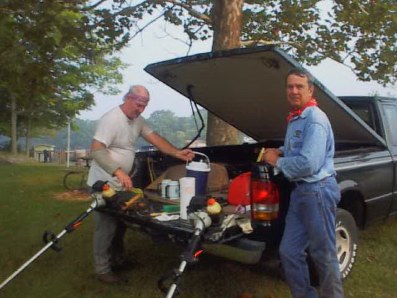East Lake Fishing Club | home
Mission | Calendar | THE RULES | Member list | Contact Us | TIPS | Related Links | Minutes | Club Pics | STATE RECORDS
TIPS


NIGHT FISHING TIP
I like to do alot of night fishing espically in the dog days of summer. One thing i've found is that if your in a boat or even beating the bank fishing for bass, put a clear red candy wrapper over your flashlite. That way your light shines red. This will help not to mess up your night vision like a clear light.
====================================================================================
Article from North American Fisherman magazine
-------------------------------------------------------------------------------------------
This booklet is published by the DNR and has a lot of information
there are 24 pages - 340 kb
______________________________________________________________
Best Fishing Days
January 2-18
February 1-16
March 2-18
April 1-16
May 1-15
May 31-June 14
June 29-July 13
July 29-August 12
August 27-September 10
September 25-October 10
October 25-November 8
November 23-December 8
December 23-January 7
PROBABLY THE BEST fishing times are when the ocean tides are restless before their turn and in the first hour of ebbing. All fish in all waters, salt and fresh, feed most heavily at those times.
Most of us go fishing when we can get time off, not because it is the best time. But there are best times, according to fishing lore:
One hour before and one hour after high tides, and one hour before and one hour after low tides.
During "the morning rise" (after sunup for a spell) and "the evening rise" (just before sundown and the hour or so after).
When the barometer is steady or on the rise. (But, of course, even in a three-day driving northeaster, the fish aren't going to give up feeding. Their hunger clock keeps right on working, and the smart fisherman will find something they want.)
When there is a hatch of flies -- caddis flies or mayflies, commonly. (The fisherman will have to match the hatching flies with his fly or go fishless.)
When the breeze is from a westerly quarter rather than from the north or east.
When the water is still or rippled, rather than during a wind.
Starting on the day the Moon is new and continuing through the day it is full.
Nineveh, In.
Latitude: 39:23:29 N Longitude: 86:06:34 W
----------------------------------------------------------------------------------------------------------------------------------------------------
Largemouth Tips
One of the most under-fished spots for northern largemouth bass are holes or pockets of open water within the weedbeds. Pockets of open water within weedbeds indicate the existence of a spring which provides cool, aerated water for bass during the summer months.
From: Babe Winkelman
---------------------------------------------------------------------------------------------------------------------------------------------------
Want to sell, buy or give something away ??
Check out the bulletin board page.
HOOK REMOVAL
It's time to start cleaning your lures and sharpening those hooks. This year might prove to be a great one. There's a lot of fish in Black Lake just waiting to be caught and sometimes scalps, fingers, hands, arms, legs, thighs, knees and an occasional rear end.
The most common accident during fishing season involves hooks. The second most common hazard facing anglers is getting too much sun. Both are easily avoided. Sunscreen and a hat will handle the sun and a first aid kit with a little knowledge of how to use it will take care of the hook problems.
The most important tool any angler should always have with him/her for removing a hook is a sharp pair of wire cutting pliers.
Here are a few methods for removing hooks.
When a hook's point and barb are protruding out the skin, it's easier to cut off the barb and back the hook out of the wound. This is when those sharp wire cutters come in handy.
The best method that seems to be recognized by most experienced hook remover professionals and even by some doctors is called the snatch method. No matter where the hook ends up this method works.
This method is quick, simple and relatively painless, as long as you get it on the first try. The secret to a first time success is yanking the loop of line, which is wrapped around the embedded hook, rather hard so the hook comes out on the first try. The reason you should get it out on the first try is obvious, the patient might not stick around for a second try.
The snatch method of hook removal is simple and effective, It's the best method to remove a hook that's deeply imbedded in the skin and when the barb is buried.
To perform the snatch method when the barb is imbedded, all that's needed is a short length of fishing line, at least 10 pound test, approximately 2 feet long.
Remove hook from lure.
Double the fishing line and loop it around the hook, as close to the skin's surface as possible.
Hold onto both ends of the doubled line, wrapping them around your hand for a firm grip and holding the line parallel to the skin's surface in line with the hook.
With your other hand, press the eye of the hook down onto the surface of the skin and back toward the hook's bend, as if trying to back the hook out of the wound.
While pressing on the hook eye, yank the line sharply, parallel to the skin and in line with the hook, to snap the hook back out of the wound.
Apply antibiotic ointment, bandage wound and check to make sure tetanus shots are current.
----------------------------------------------------------------------------------------------------------------------------------------------------
====================================================================================
If you have a good tip to post here E-Mail it to

Thank you Jim and Gary
If you see these guys give them a thumbs up and a nod they are responsible for keeping the dam mowed.
EXCELLENT JOB !!